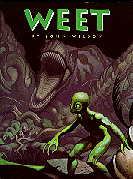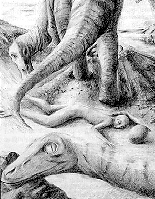


|
Weet.
John Wilson.
Grades 5 - 9 / Ages 10 - 14.
|
excerpt:
Weet turned again and slowly led them into trees.
As they walked, Eric found comfort in talking. "You know, l think I've seen Weet before."
"How could you?" Rose was doubtful. "We've never been here before. Was he in one of your dreams?"
"No, but there's a picture in one of my books. Someone made a model of what he thought dinosaurs might have evolved into if they hadn't died out. It looked a lot like Weet, but it was just guesswork. No one realized that they could have evolved into this before they died out."
"Hasn't anyone found his bones?" Rose seemed unconcerned that the green figure in front of them should have turned to stone long ago.
"No" Eric replied thoughtfully. "Maybe his bones are too fragile to be preserved, or maybe there aren't very many of them."
"How old do you think he is?" Rose's question surprised Eric.
"Sixty-five million and something," he replied, with more flippancy than he felt.
 Dinosaurs have always been a popular subject for youth fiction and non-fiction. Adults, too, are fascinated with the subject. Some researchers have speculated on how the dinosaurs might have evolved had they not died out. That brings us to Weet. John Wilson explores the idea that some dinosaurs evolved into intelligent, social humanoids before they went extinct.
Dinosaurs have always been a popular subject for youth fiction and non-fiction. Adults, too, are fascinated with the subject. Some researchers have speculated on how the dinosaurs might have evolved had they not died out. That brings us to Weet. John Wilson explores the idea that some dinosaurs evolved into intelligent, social humanoids before they went extinct.

Recommended.
Caroline Thomson is a librarian in North York, Ontario. She holds an M.A. in history.
If you would like to comment on this review or anything else in CM please send mail to cmeditor@mts.net
![]()
Copyright © 1995 the Manitoba Library Association.
Reproduction for personal use is permitted only if this copyright notice
is maintained. Any other reproduction is prohibited without permission.
Published by
The Manitoba Library Association
ISSN 1201-9364
 Go back to CM Welcome page
Go back to CM Welcome page
 Go back to Table of
Contents for this Issue
Go back to Table of
Contents for this Issue